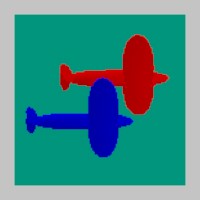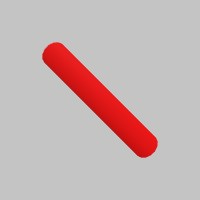#[repr(C)]pub struct RenderList(pub NonNull<_RenderListT>);Expand description
A RenderList is a collection of Draw commands that can be submitted to various surfaces. RenderList.Primary is where all normal Draw calls get added to, and this RenderList is renderer to primary display surface.
Manually working with a RenderList can be useful for “baking down matrices” or caching a scene of objects. Or for drawing a separate scene to an offscreen surface, like for thumbnails of Models. https://stereokit.net/Pages/StereoKit/RenderList.html
§Examples
use stereokit_rust::{maths::{Vec3, Matrix, Rect}, model::Model, util::Color128,
tex::{Tex, TexType, TexFormat}, material::Material,
mesh::Mesh, render_list::RenderList, system::RenderClear};
let model = Model::from_file("plane.glb", None).unwrap().copy();
let render_tex = Tex::gen_color(Color128::WHITE, 128, 128,
TexType::Rendertarget, TexFormat::RGBA32);
let mut render_mat = Material::unlit().copy();
render_mat.diffuse_tex(&render_tex);
let at = Vec3::new(-2.0, 1.0, 1000.9);
let perspective = Matrix::perspective(45.0, 1.0, 0.01, 1010.0);
let transform_plane = Matrix::r([90.0, 90.0, 145.0]);
let transform_cam = Matrix::look_at(at, Vec3::ZERO, Some(Vec3::new(1.0, 1.0, 1.0)));
let mut render_list = RenderList::new();
render_list.add_model(&model, None, transform_plane, Color128::WHITE, None);
let screen = Mesh::screen_quad();
filename_scr = "screenshots/render_list.jpeg";
test_screenshot!( // !!!! Get a proper main loop !!!!
// The color will change so we redraw every frame
render_list.draw_now( &render_tex,
transform_cam,
perspective,
Some(Color128::new((iter % 100) as f32 * 0.01, 0.3, 0.2, 0.5)),
Some(RenderClear::Color),
Rect::new(0.0, 0.0, 1.0, 1.0),
None,
);
screen.draw(token, &render_mat, Matrix::IDENTITY, None, None);
);
Tuple Fields§
§0: NonNull<_RenderListT>Implementations§
Source§impl RenderList
impl RenderList
Sourcepub fn new() -> Self
pub fn new() -> Self
Creates a new empty RenderList. https://stereokit.net/Pages/StereoKit/RenderList/RenderList.html
see also render_list_create
§Examples
use stereokit_rust::{maths::Matrix, util::Color128,
material::Material, mesh::Mesh, render_list::RenderList};
let mut render_list = RenderList::new();
assert! (render_list.get_id().starts_with("auto/render_list_"));
assert_eq!(render_list.get_count(), 0);
render_list.add_mesh(Mesh::cube(), Material::unlit(), Matrix::IDENTITY, Color128::WHITE, None);
assert_eq!(render_list.get_count(), 1);Sourcepub fn find<S: AsRef<str>>(id: S) -> Result<RenderList, StereoKitError>
pub fn find<S: AsRef<str>>(id: S) -> Result<RenderList, StereoKitError>
Looks for a RenderList matching the given id! https://stereokit.net/Pages/StereoKit/RenderList/Find.html
id- The id of the RenderList we are looking for.
see also render_list_find
§Examples
use stereokit_rust::{maths::Matrix, util::Color128,
material::Material, mesh::Mesh, render_list::RenderList};
let mut render_list = RenderList::new();
render_list.id("my_render_list");
let same_list = RenderList::find("my_render_list").expect("my_render_list should be found");
assert_eq!(render_list, same_list);Sourcepub fn clone_ref(&self) -> RenderList
pub fn clone_ref(&self) -> RenderList
Creates a clone of the same reference. Basically, the new variable is the same asset. This is what you get by calling find() method. https://stereokit.net/Pages/StereoKit/RenderList/Find.html
see also render_list_find RenderList::find
§Examples
use stereokit_rust::{maths::Matrix, util::Color128,
material::Material, mesh::Mesh, render_list::RenderList};
let mut render_list = RenderList::new();
let same_list = render_list.clone_ref();
assert_eq!(render_list, same_list);Sourcepub fn id<S: AsRef<str>>(&mut self, id: S) -> &mut Self
pub fn id<S: AsRef<str>>(&mut self, id: S) -> &mut Self
sets the unique identifier of this asset resource! This can be helpful for debugging, managing your assets, or finding them later on! https://stereokit.net/Pages/StereoKit/RenderList/Id.html
see also render_list_set_id
§Examples
use stereokit_rust::{maths::Matrix, util::Color128,
material::Material, mesh::Mesh, render_list::RenderList};
let mut render_list = RenderList::new();
render_list.id("my_render_list");
assert_eq!(render_list.get_id(), "my_render_list");Sourcepub fn clear(&mut self) -> &mut Self
pub fn clear(&mut self) -> &mut Self
Clears out and de-references all Draw items currently in the RenderList. https://stereokit.net/Pages/StereoKit/RenderList/Clear.html
see also render_list_clear
§Examples
use stereokit_rust::{maths::Matrix, util::Color128,
material::Material, mesh::Mesh, render_list::RenderList};
let mut render_list = RenderList::new();
assert! (render_list.get_id().starts_with("auto/render_list_"));
assert_eq!(render_list.get_count(), 0);
render_list.add_mesh(Mesh::cube(), Material::unlit(), Matrix::IDENTITY, Color128::WHITE, None);
assert_eq!(render_list.get_count(), 1);
assert_eq!(render_list.get_prev_count(), 0);
render_list.clear();
assert_eq!(render_list.get_count(), 0);
assert_eq!(render_list.get_prev_count(), 1);Sourcepub fn add_mesh(
&mut self,
mesh: impl AsRef<Mesh>,
material: impl AsRef<Material>,
transform: impl Into<Matrix>,
color_linear: impl Into<Color128>,
layer: Option<RenderLayer>,
) -> &mut Self
pub fn add_mesh( &mut self, mesh: impl AsRef<Mesh>, material: impl AsRef<Material>, transform: impl Into<Matrix>, color_linear: impl Into<Color128>, layer: Option<RenderLayer>, ) -> &mut Self
Add a Mesh/Material to the RenderList. The RenderList will hold a reference to these Assets until the list is cleared. https://stereokit.net/Pages/StereoKit/RenderList/Add.html
mesh- A valid Mesh you wish to draw.material- A Material to apply to the Mesh.transform- A transformation Matrix relative to the current Hierarchy.colorLinear- A per-instance linear space color value to pass into the shader! Normally this gets used like a material tint. If you’re adventurous and don’t need per-instance colors, this is a great spot to pack in extra per-instance data for the shader!layer- All visuals are rendered using a layer bit-flag. By default, all layers are rendered, but this can be useful for filtering out objects for different rendering purposes! For example: rendering a mesh over the user’s head from a 3rd person perspective, but filtering it out from the 1st person perspective.
see also render_list_add_mesh
§Examples
use stereokit_rust::{maths::{Vec3, Matrix, Rect}, util::{named_colors, Color128},
tex::{Tex, TexType, TexFormat}, material::Material,
mesh::Mesh, render_list::RenderList, system::{RenderClear, RenderLayer}};
let cylinder1 = Mesh::generate_cylinder(0.3, 1.5, [ 0.5, 0.5, 0.0],None);
let cylinder2 = Mesh::generate_cylinder(0.3, 1.5, [-0.5, 0.5, 0.0],None);
let cylinder_mat = Material::pbr();
let at = Vec3::new(-80.0, 1.0, 80.0);
let perspective = Matrix::perspective(45.0, 1.0, 0.01, 120.0);
let transform_cam = Matrix::look_at(at, Vec3::ZERO, None);
let mut render_list = RenderList::new();
render_list
.add_mesh(&cylinder1, &cylinder_mat, Matrix::IDENTITY, named_colors::CYAN, None)
.add_mesh(&cylinder2, &cylinder_mat, Matrix::IDENTITY, named_colors::FUCHSIA,
Some(RenderLayer::Layer1));
let render_tex = Tex::gen_color(Color128::WHITE, 128, 128,
TexType::Rendertarget, TexFormat::RGBA32);
let mut render_mat = Material::unlit().copy();
render_mat.diffuse_tex(&render_tex);
let screen = Mesh::screen_quad();
render_list.draw_now( &render_tex,
transform_cam,
perspective,
Some(Color128::new(0.99, 0.3, 0.2, 0.5)),
Some(RenderClear::Color),
Rect::new(0.0, 0.0, 1.0, 1.0),
Some(RenderLayer::AllThirdPerson),
);
filename_scr = "screenshots/render_list_add_mesh.jpeg";
test_screenshot!( // !!!! Get a proper main loop !!!!
screen.draw(token, &render_mat, Matrix::IDENTITY, None, None);
);
Sourcepub fn add_model(
&mut self,
model: impl AsRef<Model>,
material_override: Option<Material>,
transform: impl Into<Matrix>,
color_linear: impl Into<Color128>,
layer: Option<RenderLayer>,
) -> &mut Self
pub fn add_model( &mut self, model: impl AsRef<Model>, material_override: Option<Material>, transform: impl Into<Matrix>, color_linear: impl Into<Color128>, layer: Option<RenderLayer>, ) -> &mut Self
Add a Model to the RenderList. The RenderList will hold a reference to these Assets until the list is cleared. https://stereokit.net/Pages/StereoKit/RenderList/Add.html
model- A valid Model you wish to draw.material- Allows you to override the Material.transform- A transformation Matrix relative to the current Hierarchy.colorLinear- A per-instance linear space color value to pass into the shader! Normally this gets used like a material tint. If you’re adventurous and don’t need per-instance colors, this is a great spot to pack in extra per-instance data for the shader!layer- All visuals are rendered using a layer bit-flag. By default, all layers are rendered, but this can be useful for filtering out objects for different rendering purposes! For example: rendering a mesh over the user’s head from a 3rd person perspective, but filtering it out from the 1st person perspective.
see also render_list_add_model render_list_add_model_mat
§Examples
use stereokit_rust::{maths::{Vec3, Matrix, Rect}, model::Model, util::{named_colors,Color128},
tex::{Tex, TexType, TexFormat}, material::Material,
mesh::Mesh, render_list::RenderList, system::{RenderClear, RenderLayer}};
let model = Model::from_file("plane.glb", None).unwrap().copy();
let at = Vec3::new(-2.0, 400.0, 1000.9);
let perspective = Matrix::perspective(45.0, 1.0, 0.01, 1550.0);
let transform_plane1 = Matrix::t([ 5.0, 2.0, 0.0]);
let transform_plane2 = Matrix::t([2.0, -6.0, -10.0]);
let transform_cam = Matrix::look_at(at, Vec3::ZERO, Some(Vec3::new(0.0, -1.0, 0.0)));
let mut render_list = RenderList::new();
render_list
.add_model(&model, None, transform_plane1, named_colors::RED, None)
.add_model(&model, None, transform_plane2, named_colors::BLUE,
Some(RenderLayer::Layer1));
let render_tex = Tex::gen_color(Color128::WHITE, 128, 128,
TexType::Rendertarget, TexFormat::RGBA32);
let mut render_mat = Material::unlit().copy();
render_mat.diffuse_tex(&render_tex);
let screen = Mesh::screen_quad();
render_list.draw_now( &render_tex,
transform_cam,
perspective,
Some(Color128::new(0.0, 0.3, 0.2, 0.5)),
Some(RenderClear::Color),
Rect::new(0.0, 0.0, 1.0, 1.0),
Some(RenderLayer::AllFirstPerson),
);
filename_scr = "screenshots/render_list_add_model.jpeg";
test_screenshot!( // !!!! Get a proper main loop !!!!
screen.draw(token, &render_mat, Matrix::IDENTITY, None, None);
);
Sourcepub fn draw_now(
&mut self,
to_rendertarget: impl AsRef<Tex>,
camera: impl Into<Matrix>,
projection: impl Into<Matrix>,
clear_color: Option<Color128>,
clear: Option<RenderClear>,
viewport_pct: Rect,
layer_filter: Option<RenderLayer>,
)
pub fn draw_now( &mut self, to_rendertarget: impl AsRef<Tex>, camera: impl Into<Matrix>, projection: impl Into<Matrix>, clear_color: Option<Color128>, clear: Option<RenderClear>, viewport_pct: Rect, layer_filter: Option<RenderLayer>, )
Draws the RenderList to a rendertarget texture immediately. It does not clear the list https://stereokit.net/Pages/StereoKit/RenderList/DrawNow.html
to_render_target- The rendertarget texture to draw to.camera- A TRS matrix representing the location and orientation of the camera. This matrix gets inverted later on, so no need to do it yourself.projection- The projection matrix describes how the geometry is flattened onto the draw surface. Normally, you’d use Matrix.Perspective, and occasionally Matrix.Orthographic might be helpful as well.clear_color* If theclearparameter is set to clear the color ofto_render_target, then this is the color it will clear to.defaultwould be a transparent black.clear- Describes if and how the render_target should be cleared before rendering. Note that clearing the target is unaffected by the viewport, so this will clean the entire surface! None is All.viewport_pct- Allows you to specify a region of the rendertarget to draw to! This is in normalized coordinates, 0-1. If the width of this value is zero, then this will render to the entire texture.layerFilter- This is a bit flag that allows you to change which layers StereoKit renders for this particular render viewpoint. To change what layers a visual is on, use a Draw method that includes a RenderLayer as a parameter.
see also render_list_draw_now
§Examples
use stereokit_rust::{maths::{Vec3, Matrix, Rect}, util::{named_colors, Color128, Color32},
tex::{Tex, TexType, TexFormat}, material::Material,
mesh::Mesh, render_list::RenderList, system::{RenderClear, RenderLayer}};
let cylinder1 = Mesh::generate_cylinder(0.3, 1.5, [ 0.5, 0.5, 0.0],None);
let cylinder2 = Mesh::generate_cylinder(0.3, 1.5, [-0.5, 0.5, 0.0],None);
let cylinder_mat = Material::pbr().copy();
let render_tex = Tex::gen_color(Color128::WHITE, 128, 128,
TexType::Rendertarget, TexFormat::RGBA32);
let mut render_mat = Material::unlit().copy();
render_mat.diffuse_tex(&render_tex);
let mut screen = Mesh::generate_cube([1.0, 1.0, 1.0], None);
let transform_screen = Matrix::t([0.0, 0.0, -1.0]);
let at = Vec3::new(-80.0, 1.0, 80.0);
let perspective = Matrix::perspective(45.0, 1.0, 0.01, 120.0);
let transform_cam = Matrix::look_at(at, Vec3::ZERO, None);
let mut render_list = RenderList::new();
render_list
.add_mesh(&cylinder1, &cylinder_mat, Matrix::IDENTITY, named_colors::CYAN, None)
.add_mesh(&cylinder2, &cylinder_mat, Matrix::IDENTITY, named_colors::FUCHSIA,None)
.add_mesh(&screen, &render_mat, transform_screen, named_colors::GRAY, None);
filename_scr = "screenshots/render_list_draw_now.jpeg";
test_screenshot!( // !!!! Get a proper main loop !!!!
screen.draw(token, &render_mat, Matrix::IDENTITY, None, None);
render_list.draw_now( &render_tex,
transform_cam,
perspective,
None,
Some(RenderClear::None),
Rect::new(0.0, 0.0, 1.0, 1.0),
None
);
);
Sourcepub fn primary() -> Self
pub fn primary() -> Self
The default RenderList used by the Renderer for the primary display surface. https://stereokit.net/Pages/StereoKit/RenderList/Primary.html
see also render_get_primary_list
§Examples
use stereokit_rust::render_list::RenderList;
let primary_list = RenderList::primary();
assert_eq! (primary_list.get_id(),"sk/render/primary_renderlist");
assert_eq! (primary_list.get_count(), 0);Sourcepub fn push(&mut self)
pub fn push(&mut self)
All draw calls that don’t specify a render list will get submitted to the active RenderList at the top of the stack. By default, that’s RenderList.Primary, but you can push your own list onto the stack here to capture draw calls, like those done in the UI. https://stereokit.net/Pages/StereoKit/RenderList/Push.html
see also render_list_push
§Examples
use stereokit_rust::{maths::{Vec3, Matrix}, util::named_colors, material::Material,
mesh::Mesh, render_list::RenderList};
let cylinder1 = Mesh::generate_cylinder(0.3, 1.5, [ 0.5, 0.5, 0.0],None);
let cylinder2 = Mesh::generate_cylinder(0.3, 1.5, [-0.5, 0.5, 0.0],None);
let cylinder_mat = Material::pbr().copy();
let mut render_list = RenderList::new();
// render_list.add_mesh(&cylinder1, &cylinder_mat, Matrix::IDENTITY, None);
filename_scr = "screenshots/render_list_push.jpeg";
test_screenshot!( // !!!! Get a proper main loop !!!!
render_list.push();
cylinder1.draw(token, &cylinder_mat, Matrix::IDENTITY, Some(named_colors::GOLD.into()), None);
RenderList::pop();
cylinder2.draw(token, &cylinder_mat, Matrix::IDENTITY, Some(named_colors::RED.into()), None);
);
Sourcepub fn pop()
pub fn pop()
This removes the current top of the RenderList stack, making the next list as active https://stereokit.net/Pages/StereoKit/RenderList/Pop.html
see also render_list_pop
see example RenderList::push
Sourcepub fn get_id(&self) -> &str
pub fn get_id(&self) -> &str
The id of this render list https://stereokit.net/Pages/StereoKit/RenderList/Id.html
see also render_list_get_id
see example RenderList::id
Sourcepub fn get_count(&self) -> i32
pub fn get_count(&self) -> i32
The number of Mesh/Material pairs that have been submitted to the render list so far this frame. https://stereokit.net/Pages/StereoKit/RenderList/Count.html
see also render_list_item_count
§Examples
use stereokit_rust::{maths::Matrix, util::Color128,
material::Material, mesh::Mesh, render_list::RenderList};
let mut render_list = RenderList::new();
assert! (render_list.get_id().starts_with("auto/render_list_"));
assert_eq!(render_list.get_count(), 0);
render_list.add_mesh(Mesh::cube(), Material::unlit(), Matrix::IDENTITY, Color128::WHITE, None);
assert_eq!(render_list.get_count(), 1);Sourcepub fn get_prev_count(&self) -> i32
pub fn get_prev_count(&self) -> i32
This is the number of items in the RenderList before it was most recently cleared. If this is a list that is drawn and cleared each frame, you can think of this as “last frame’s count”. https://stereokit.net/Pages/StereoKit/RenderList/PrevCount.html
see also render_list_prev_count
§Examples
use stereokit_rust::{maths::Matrix, util::Color128,
material::Material, mesh::Mesh, render_list::RenderList};
let mut render_list = RenderList::new();
assert! (render_list.get_id().starts_with("auto/render_list_"));
assert_eq!(render_list.get_prev_count(), 0);
render_list.add_mesh(Mesh::cube(), Material::unlit(), Matrix::IDENTITY, Color128::WHITE, None);
assert_eq!(render_list.get_prev_count(), 0);
render_list.clear();
assert_eq!(render_list.get_count(), 0);
assert_eq!(render_list.get_prev_count(), 1);Trait Implementations§
Source§impl AsRef<RenderList> for RenderList
impl AsRef<RenderList> for RenderList
Source§fn as_ref(&self) -> &RenderList
fn as_ref(&self) -> &RenderList
Source§impl Debug for RenderList
impl Debug for RenderList
Source§impl Default for RenderList
impl Default for RenderList
Source§impl Drop for RenderList
impl Drop for RenderList
Source§impl IAsset for RenderList
impl IAsset for RenderList
Source§fn get_id(&self) -> &str
fn get_id(&self) -> &str
Source§impl PartialEq for RenderList
impl PartialEq for RenderList
impl StructuralPartialEq for RenderList
Auto Trait Implementations§
impl Freeze for RenderList
impl RefUnwindSafe for RenderList
impl !Send for RenderList
impl !Sync for RenderList
impl Unpin for RenderList
impl UnwindSafe for RenderList
Blanket Implementations§
Source§impl<T> BorrowMut<T> for Twhere
T: ?Sized,
impl<T> BorrowMut<T> for Twhere
T: ?Sized,
Source§fn borrow_mut(&mut self) -> &mut T
fn borrow_mut(&mut self) -> &mut T
Source§impl<T> Downcast for Twhere
T: Any,
impl<T> Downcast for Twhere
T: Any,
Source§fn into_any(self: Box<T>) -> Box<dyn Any>
fn into_any(self: Box<T>) -> Box<dyn Any>
Box<dyn Trait> (where Trait: Downcast) to Box<dyn Any>. Box<dyn Any> can
then be further downcast into Box<ConcreteType> where ConcreteType implements Trait.Source§fn into_any_rc(self: Rc<T>) -> Rc<dyn Any>
fn into_any_rc(self: Rc<T>) -> Rc<dyn Any>
Rc<Trait> (where Trait: Downcast) to Rc<Any>. Rc<Any> can then be
further downcast into Rc<ConcreteType> where ConcreteType implements Trait.Source§fn as_any(&self) -> &(dyn Any + 'static)
fn as_any(&self) -> &(dyn Any + 'static)
&Trait (where Trait: Downcast) to &Any. This is needed since Rust cannot
generate &Any’s vtable from &Trait’s.Source§fn as_any_mut(&mut self) -> &mut (dyn Any + 'static)
fn as_any_mut(&mut self) -> &mut (dyn Any + 'static)
&mut Trait (where Trait: Downcast) to &Any. This is needed since Rust cannot
generate &mut Any’s vtable from &mut Trait’s.